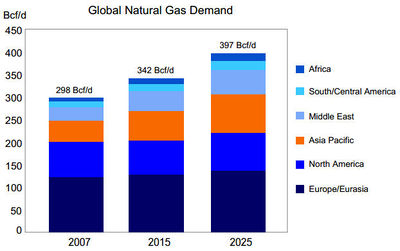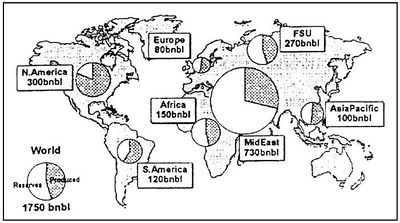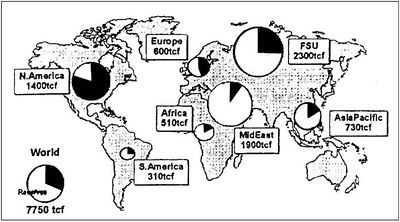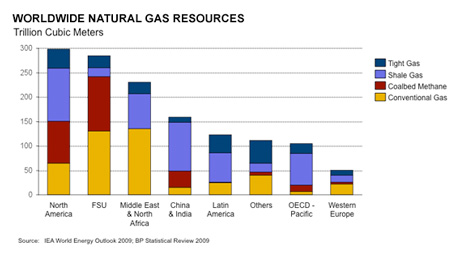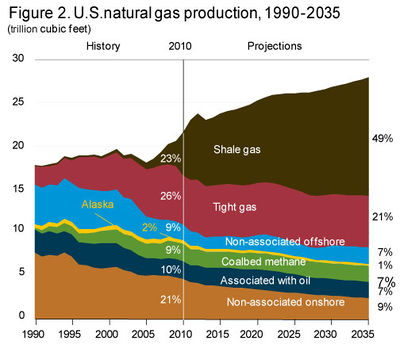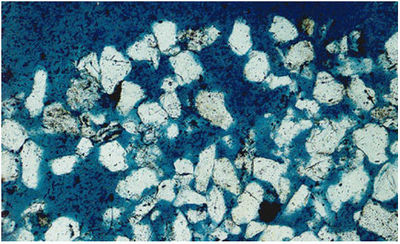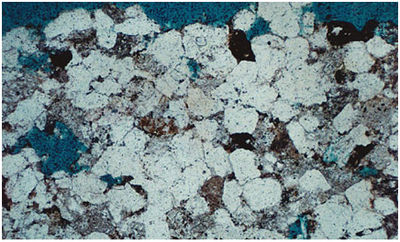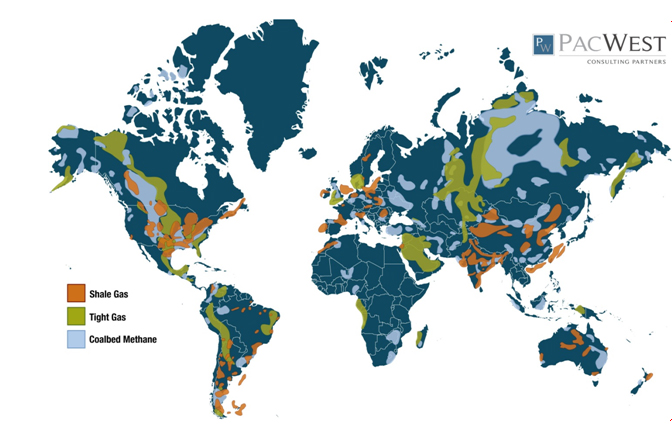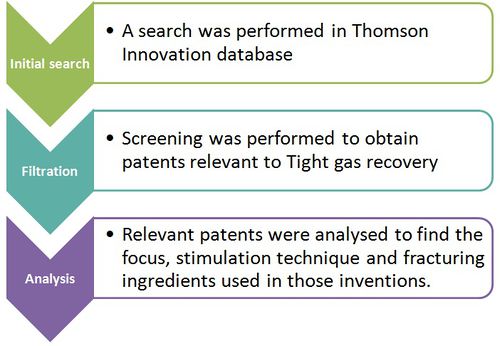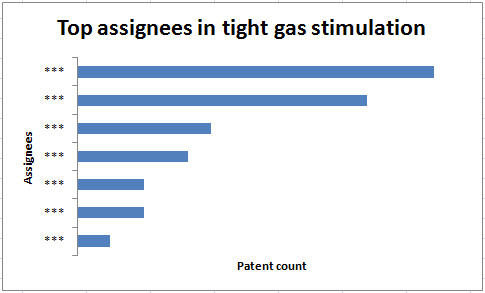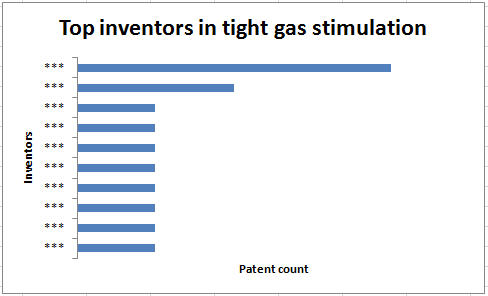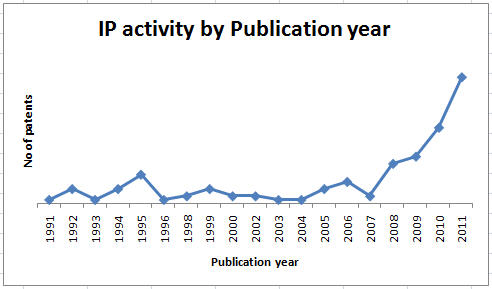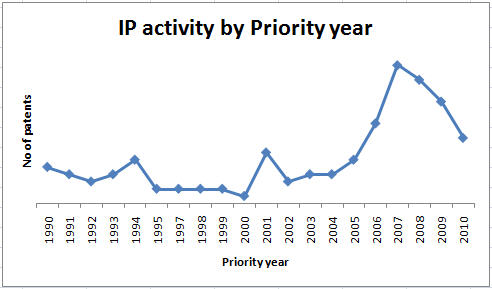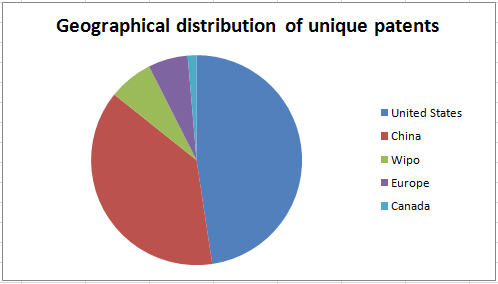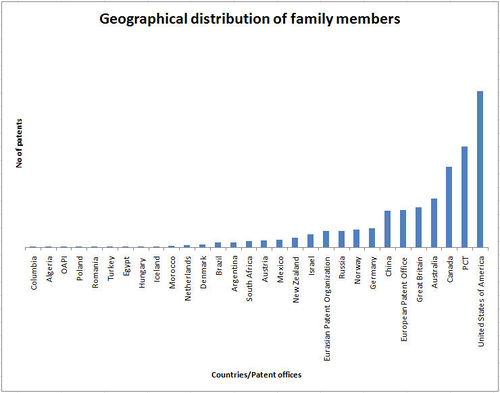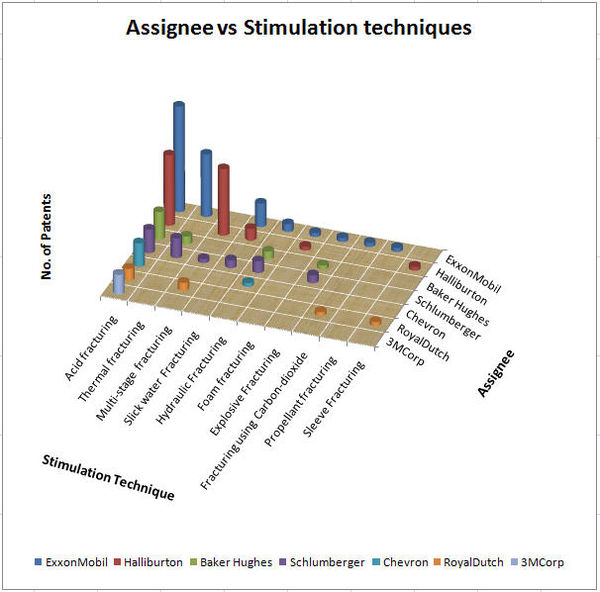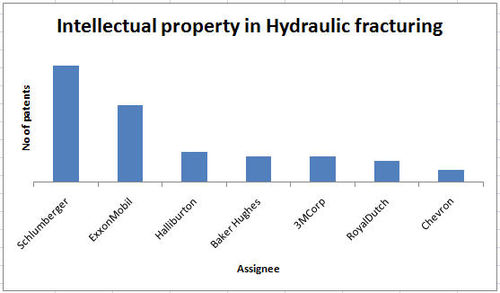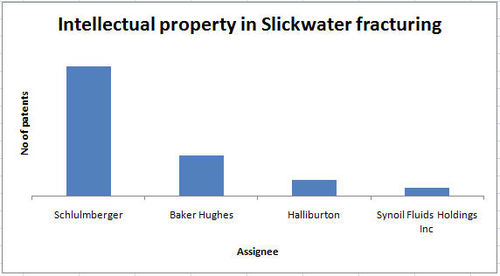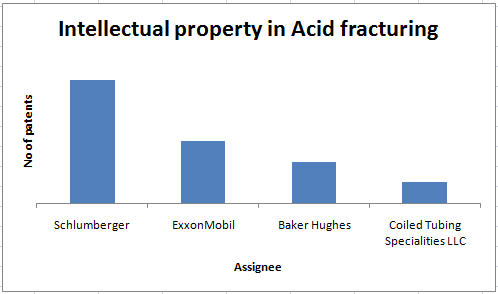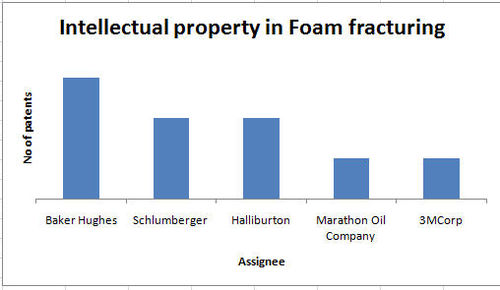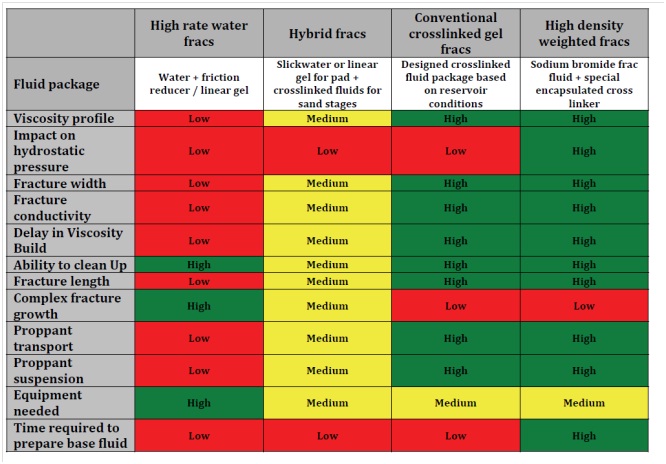Difference between revisions of "Tight Gas Fracturing Technology and Patent Report"
(→High pressure & high temperature (HPHT) fracturing) |
(→High pressure & high temperature (HPHT) fracturing) |
||
| Line 788: | Line 788: | ||
'''Summary of High pressure & high temperature (HPHT) fracturing''' | '''Summary of High pressure & high temperature (HPHT) fracturing''' | ||
| − | + | Saudi Aramco in 2009 used sodium bromide (Nabr brine)for fracturing wells....[Contd] | |
Revision as of 02:42, 3 July 2012
Contents
- 1 Background
- 1.1 Introduction
- 1.2 Tight Gas
- 1.2.1 Conventional and Unconventional Reservoirs
- 1.2.2 Properties of Tight Gas
- 1.2.3 Map of unconventional reserves (Shale,Tight,Coalbed methane) in the world
- 1.2.4 Distribution of Tight Gas across the world
- 1.2.5 Recovery of Tight Gas
- 1.2.6 Challenges for Tight Gas Recovery
- 1.2.7 Taxonomy for various technical challenges in tight gas recovery
- 2 Methodology for Patent Search
- 3 Taxonomy for patent analysis for tight gas recovery
- 4 Stimulation Techniques
- 4.1 Graphical representation of Assignee vs Stimulation techniques
- 4.2 Hydraulic Fracturing
- 4.3 Multi Stage Fracturing
- 4.4 Slickwater Fracturing
- 4.5 Acid Fracturing
- 4.6 Carbon dioxide Fracturing
- 4.7 Foam Fracturing
- 4.8 Explosive Fracturing
- 4.9 Sleeve fracturing
- 4.10 Hydrocarbon recovery by using biogenic materials combined with Pneumatic fracturing
- 4.11 Chemical reaction induced pressure pulses fracturing
- 4.12 Propellant Fracturing
- 4.13 High pressure & high temperature (HPHT) fracturing
Background
Introduction
Global demand for natural gas is increasing day by day as due to rapidly growing gas market of developing countries. As more nations are switching to environmentally cleaner fuels to maintain the economic growth and reducing the impact of increasing high oil price. Natural gas is emerged as an excellent environmentally clean fuel as it emits 43% fewer carbon emissions the coal and 30% fewer emissions than oil for each energy delivered. In order to fulfill the increasing demand of energy requirement and reducing greenhouse gas emission. “The quickest and cheapest way to cut CO2 emissions from the global power sector is to grow the presence of natural gas,” said Shell’s exploration Chief Malcolm Brinded in a speech late last year. Shell-Malcolm Brinded
Global Natural Gas Demand
According to the U.S. Energy Information Agency (EIA) latest report the global demand for natural gas is expected to grow significantly as more nations are switching to environmentally cleaner fuels such as Natural Gas. Majority of the rapidly growing gas markets are in emerging economies in Asia, particularly India and China, the Middle East and South America. EIA also shows worldwide natural gas demand grew by 57 Bcf/d from 2000 to 2007, nearly 25%. The EIA also projects global natural gas demand to grow over 40 Bcf/d by the year 2015, and projects a further growth in demand of over 50 Bcf/d by 2025.
Outlook for LNG.pdf EIA-Report
Current Scenario
Bentley R. W., 2002 of The Oil Depletion Analysis Centre London studied on Global oil & gas depletion: An overview. It shows that the world’s production of conventional hydrocarbons will soon decline. Global conventional oil supply is currently at political and physical risk. This is because the sum of conventional oil production from all countries in the world, except the five main Middle-East suppliers, is near the maximum set by physical resource limits. A large investment in Middle-East oil production is needed to overcome this physical risk, and to fulfill the increasing demand of hydrocarbon across the globe. Figure 2 Shows the global conventional oil distribution of the world’s, conventional oil that has been consumed (dark shading), and the currently discovered reserves (light colour). The figure uses industry (proved and probable) data for reserves (not public domain ’proved’ reserves), and excludes oil yet to- find. The major concluding points from this figure shows the world is about halfway through its effective recoverable resource base and North America has burnt about three-quarters of its recoverable conventional oil resource.
For conventional gas, since less gas has been used so far compared to oil, the world will increases its dependability to gas as oil declines. Figure 3 Shows the global conventional gas distribution of the world’s, conventional gas that has been consumed (dark shading), and the currently discovered reserves (light colour). The figure uses industry (proved and probable) data for reserves (not public domain ’proved’ reserves), and excludes oil yet to- find. The major concluding points are Europe has a little way to go before its gas peak, and the world as a whole is about halfway to its gas peak. When the ’clocks’ on this figure tick round to perhaps 8 or 9 o’clock, gas decline sets in with the decline likely to be fairly steep.
Present scenario shows that with the physical resource limits and depletion of oil there is exponential increase the demand of gas. The global peak in all hydrocarbons (oil plus gas) is likely to be in about 10 or so years. Thus there is do or die situation for development of unconventional reservoir across the globe for avoiding the situation of energy crisis in the world. http://greatchange.org/ov-bentley,global_depletion.pdf Global Depletion-Bentley
Natural Gas Distribution
Worldwide Natural gas resources shows North America contain the largest reserves of 300 Trillion cubic meters in which unconventional resources is around 230 Trillion cubic meters. Former Soviet country shows second largest reserves of 270 Trillion cubic meters in which unconventional resources is around 140 Trillion cubic meters. China and India also contain the reserves of 160 Trillion cubic meters in which unconventional resources is around 145 Trillion cubic meters. African countries, Latin America, Western Europe and others show the presence of Unconventional resources.
Worldwide Natural gas resources
U.S. Energy Information Administration’s preview of its 2012 Annual Energy Outlook is the forecast for natural gas. EIA says that gas from shale and tight gas will account for 70 percent of the United States’ overall natural gas supply in 2035. It is clearly visible from the Figure 5 that there’s been a surge in shale gas production since roughly 2005. The major reason for this surge in shale gas production is due to surge in new hydraulic fracturing and horizontal drilling techniques, which helps in unlocking vast shale gas formations in states including Pennsylvania, North Dakota and Texas. And similar development is dawning in Ohio and other states too of North America.EIA-Shale report
Tight Gas
- Tight gas refers to natural gas reservoirs locked in extraordinarily impermeable, hard rock, making the underground formation extremely "tight." Tight gas can also be trapped in sandstone or limestone formations that are typically impermeable or nonporous, also known as tight sand. In other words, the pores in the rock formation in which the gas is trapped are either irregularly distributed or badly connected with overly narrow capillaries, lessening permeability or the ability of the gas to travel through the rock. Without secondary production methods, gas from a tight formation would flow at very slow rates, making production uneconomical.
- While conventional gas formations tend to be found in the younger Tertiary basins, tight gas formations are much older. Deposited some 248 million years ago, tight gas formations are typically found in Paleozoic formations. Over time, the rock formations have been compacted and have undergone cementation and recrystallisation, which all reduce the level of permeability in the rock. Tight gas-Rigzone.
Conventional and Unconventional Reservoirs
Conventional reservoirs are those that can be produced at economic flow rates and that will produce economic volumes of oil and gas without large stimulation treatments or any special recovery process. Conventional reservoir is essentially a high to medium permeability reservoir in which one can drill a vertical well, perforate the pay interval, and then produce the well at commercial flow rates and recover economic volumes of oil and gas.
Unconventional reservoir is one that cannot be produced at economic flow rates. Typical unconventional reservoirs are tight-gas sands, coal-bed methane, heavy oil, and gas shales. Unlike conventional reservoirs, which are small in volume but easy to develop, unconventional reservoirs are large in volume but difficult to develop. Increasing price and the improved technology are the key to their development and the future. Unconventional resources are probably very large, but their character and distribution are not yet well understood. It is known to exist in large quantity but does not flow easily toward existing wells for economic recovery.
Increase in cost and technological challenges when moving from conventional to unconventional gas recovery methods. Tight Gas Reservoirs--GC Naik.
- Conventional gas picture: Thin section of a conventional sandstone reservoir that has been injected with blue epoxy. The blue areas are pore space and would contain natural gas in a producing gas field. The pore space can be seen to be interconnected so gas is able to flow easily from the rock.
- Unconventional gas picture: Thin section Photo of a tight gas sandstone. The blue areas are pores. The pores are irregularly distributed through the reservoir and the porosity of the rock can be seen to be much less than the conventional reservoir.
Unconventional Gas Resources Typical unconventional reservoirs are
- Tight-gas Sands - formed in sandstone or carbonate (called tight gas sands) with low permeability which prevents the gas from flowing naturally.
- Coal-bed Methane - formed in coal deposits and adsorbed by coal particles.
- Gas Shales - formed in fine-grained shale rock (called gas shales) with low permeability in which gas has been adsorbed by clay particles or is held within minute pores and microfractures.
- Methane Hydrates – a crystalline combination of natural gas and water, formed at low temperature and high pressure in places such as under the oceans and permafrost
Properties of Tight Gas
| S. No | Properties of Tight Gas | |
| 1 | Matrix permeability | 1 µD to 0.1 mD |
| 2 | Porosity | 3-5% to 15-20 % (effective) |
| 3 | No or limited natural flow | Typically the initial flow before stimulation is less than 0.5 MMscfd (~15.000 Sm3/d) |
Source: Total, EBN – TNO Tight Gas Symposium
Map of unconventional reserves (Shale,Tight,Coalbed methane) in the world
- The world map representing unconventional gas reserves in various regions. It includes Shale gas, Coalbed methane and Tight gas.
Distribution of Tight Gas across the world
| S.No | Region | Tight-Sand Gas Volume (Trillion-cubic feet) |
| 1 | North America | 1,371 |
| 2 | Latin America | 1,293 |
| 3 | Western Europe | 353 |
| 4 | Central and Eastern Europe | 78 |
| 5 | Former Soviet | 901 |
| 6 | Union Middle East and North Africa | 823 |
| 7 | Sub-Saharan Africa | 784 |
| 8 | Centrally planned Asia and China | 353 |
| 9 | Pacific (Organization for Economic Cooperation and Development) | 705 |
| 10 | Other Asia Pacific | 549 |
| 11 | South Asia | 196 |
| 12 | World | 7,406 |
Recovery of Tight Gas
The steps involved in tight gas recovery are:
- Seismic investigation: Extensive seismic data is gathered and analyzed to determine where to drill and just what might be located below the earth's surface. These seismic surveys can help to pinpoint the best areas to tap tight gas reserves. Not only providing operators with the best locations for drilling wells into tight gas formations, extensive seismic surveys can help drilling engineers determine where and to what extent drilling directions should be deviated.
- Drilling: In a tight gas formation, it is important to expose as much of the reservoir as possible, making horizontal and directional drilling a must. Here, the well can run along the formation, opening up more opportunities for the natural gas to enter the wellbore.A common technique for developing tight gas reserves includes drilling more wells. The more the formation is tapped, the more the gas will be able to escape the formation. This can be achieved through drilling myriad directional wells from one location, lessening the operator's footprint and lowering costs.
- Production Stimulation: After seismic data has illuminated the best well locations, and the wells have been drilled, production stimulation is employed on tight gas reservoirs to promote a greater rate of flow. Production stimulation can be achieved on tight gas reservoirs through both fracturing and acidizing the wells.
- Hydraulic Fracturing: Fracturing, also known as "fracing," a well involves breaking the rocks in the formation apart. Performed after the well has been drilled and completed, hydraulic fracturing is achieved by pumping the well full of frac fluids under high pressure to break the rocks in the reservoir apart and improve permeability, or the ability of the gas to flow through the formation.
- Acidizing: Acidizing the well is employed to improve permeability and production rates of tight gas formations. Acidation involves pumping the well with acids that dissolve the limestone, dolomite and calcite cement between the sediment grains of the reservoir rocks. This form of production stimulation helps to reinvigorate permeability by reestablishing the natural fissures that were present in the formation before compaction and cementation.
- Deliquification: Furthermore, deliquification of the tight gas wells can help to overcome some production challenges. In many tight gas formations, the reservoirs also contain small amounts of water. This water can collect and undermine production processes. Deliquification is achieved in this instance through artificial lift techniques, such as using a beam pumping system to remove the water from the reservoir, although this has not proven the most effective way to overcome this challenge.
Challenges for Tight Gas Recovery
- During the last decade new technologies as 3-D seismic, horizontal drilling, and improved fracture stimulation have had significant impacts on natural gas production in many tight gas reservoirs in Middle East and North Africa. Some of the challenges in this recovery are:
1) Sub-Surface Understanding
2) Formation Evaluation Technology
3) Drilling Technology
4) Completion & Stimulation Technology
5) Environmental safety
- Geomechanics and Sub-Surface Understanding: Fundamental to any improvement in performance is done by having a clear understanding of the sub-surface environment. Understanding permeability, although at very low values compared to conventional reservoirs, is a key to maximizing productive capabilities. Subtle differences in tight gas reservoir properties can result in large changes in permeability, and mark the difference between productive and non-productive intervals.Geomechanics and subsurface understanding is a critical component in understanding the nature of the formation. All companies recognise the need to use geomechanics to assess natural fracture patterns.
- Formation Evaluation Technology: The objectives of Formation Evaluation are,to ascertain if commercially producible hydrocarbons are present, determine the best means for their recovery, to derive lithology and other information on formation characteristics for use in further exploration and development. Lack of accuracy for all porosity logs. There are strong limits to the application of NMR logging in low porosity, low permeability gas bearing formation.
- Drilling Technology: The challenge in any tight gas development is to use technology to push up the estimated ultimate recovered volume per well, and the produced volumes (flow), while simultaneously pushing down costs. Specialized drilling practices, application of drill bits for less wellbore damage , Specialized drilling fluids are few challenges that is to be overcomed.
- Completion & Stimulation Technology: One of the most important areas where technology can make a difference, is the ability to make small but extensive fractures in the correct places in the tight rock (‘fraccing’). This provides the gas molecules with a passage to move more easily through the reservoir to the wellbore. Fracturing techniques use a significant amount of energy to create the pressure used to crack the rock open. The first hydraulic fracturing job to be run commercially in the 1940s required just a few hundred horsepower. More recently, in examples such as the Pinedale field, power requirements can be as high as 25,000 horsepower, and costs can represent up to 30% of the well costs. Any possibility to make this more efficient has significant cost implications.
- Environmental Safety: Drilling of hundreds of wells represents a major environmental and safety challenge. Shell is tackling this challenge and is focused on improving well performance and surface engineering, which will push the business forward in a sustainable manner. Tight Gas Developments-IGU.org, Unconventional gas-NPC.org
Taxonomy for various technical challenges in tight gas recovery
Methodology for Patent Search
A detailed search strategy was formulated to extract relevant patents in the area. Keywords were obtained from some relevant patents, journal articles, company websites and other thesauri. Class-codes were obtained from the background reading and citation check of few relevant patents and from different other databases like USPTO, WIPO and Espacenet. Class-codes related to drilling of boreholes and well development was taken into consideration. Comprehensive search strategy was made using the combination of different keywords and complimentary class-codes in order to obtain all the relevant patents and at the same time keep away from irrelevant records.
Process-flow for patent analysis
Database used: Thomson Innovation
Countries Covered: US Grant, GB App, US App, FR App, WO App, DE Util, EP Grant, DE Grant, EP App, DE App, JP Util, JP Grant, JP App, CN Util, CN App, KR Util , KR Grant, KR App, DWPI
Years searched: Priority date: 1990-01-01 to 2011-12-22
Date of search: 22nd December 2011
Keywords: The keywords used for different concepts are
- Tight Gas: Tight gas, tight sand, tight carbonate, tight formation, tight deposit, tight strata, tight medium, impermeable formation, impermeable deposit, impermeable strata, impermeable medium, impermeable reservoir etc.
- Stimulation: Stimulation, fracturing etc.
Insights from patent analysis
All the patents obtained from the database were filtered to find out the most relevant patents, this process included going through the full text of the patent. Relevant patents related to stimulation technique for tight gas formations were found. This was followed by a detailed analysis of the relevant records. All the patents were analyzed to capture the focus of the patent, stimulation technique described in the invention and the fracturing ingredients used in the invention. The analyses of the patents lead to following observations:
Top Assignees
Schlumberger, Exxonmobil and Halliburton feature in this list.
IP Activity
The publications of patents in the last were nearly stagnant till 2007 after which one can witness a sudden surge in publication related to tight gas stimulation. For the years 1997 and 2001 there was no publication of patents related to tight gas stimulation. The last 3 years (2008-2011) has witnessed a sudden growth of publication activity, the highest being in 2011.
The IP activity by priority year saw a sudden surge in activity in the year 1994 and thereafter from 2005 onwards, where a significant IP activity was observed. The numbers are more likely to change when patents claiming priority over the last 20 years are published. There was no IP activity observed in the year 1996.
Geographical Distribution of patents
a) By unique families Since the unique family retrieved from Thomson Innovation Database was downloaded by keeping US as a first priority, hence one can see that US leads in the chart.
b) Total patent families filed across the globe
As shown in the above figure, United States has the highest filing of patent families filed across the globe. The filing spread is seen across North and South America, Europe, Russia and Australia. PCT filing also remains an important choice of assignees when it comes to filing patent globally.
Technology and Scientific Information Search Strategy
A search for extracting scientific articles was conducted.
Database used: Engineering Village (Compendex)
Scope: Subject/Title/Abstract
Years Searched: 1990-2012
Date of search: 02nd January 2012
Criteria for filtering: Only those articles related to stimulation or fracturing techniques for tight gas recovery were considered as relevant. Articles related to modeling were considered as OFF target documents. Duplicate articles were removed.
Taxonomy for patent analysis for tight gas recovery
Stimulation Techniques
Graphical representation of Assignee vs Stimulation techniques
Different types of fracturing techniques are used for stimulation of tight gas reservoir. Here we have covered the patents and articles which are focusing on the application of fracturing technique for the development of the tight gas reservoir.
Hydraulic Fracturing
Graphical Representation of Assignee's holding patents of Hydraulic fracturing
Table: Hydraulic fracturing patent of different Companies.
| Hydraulic Fracturing | |||
| S.No | Assignee | Patent | Comment |
| 1 | Halliburton | US20110209868A1 | Fracturing of stress altered formation using signaling subsystem communicably coupled with injection tools installed in the well bore. |
| US20090288833A1 | Fracturing of multiple ultra-shot radius laterals from a parent well | ||
| 2 | Schlumberger | **** | **** |
| **** | **** | ||
| **** | **** | ||
| 3 | ### | **** | **** |
| 4 | ### | **** | **** |
| 5 | ### | **** | **** |
These sections now concentrate on the work done by the companies or institutes.
Halliburton
US20110209868A1 titled "Fracturing a stress-altered subterranean formation" by Halliburton. Fracturing of a stress- altered subterranean formation is difficult to perform. Fracturing of stress altered formation using signaling subsystem communicably coupled with injection tools installed in the well bore.
Signaling subsystem adapted to transmit control signals from a well bore surface to each injection tool to change the state of the injection tool according to stress condition.
It can modified stresses, thus fracture network can be created along a substantial portion of a horizontal well bore.
US20090288833A1 titled "System and methods for constructing and fracture stimulating multiple ultra-short radius laterals from a parent well" by Halliburton. Hydrocarbons are often dispersed in a stacked sequence in the reservoir. The reservoir also contains water bearing zones. Conventional equipment cannot be used for drilling and stimulation of multi lateral well as they are very time consuming, and expensive in nature. It provide a systems and methods for constructing multiple ultra-shot radius laterals from a parent well and stimulating the subterranean zones intersected by multiple lateral wellbores extending outwardly from one or more parent wellbores by injecting a stimulation fluid into the lateral wellbores; and stimulating the zones intersected by the lateral wellbores.
....[Contd]
Schlumberger
.....[Contd]
Information from the Article
Many authors have talked about massive hydraulic fracturing Ahmed et al. in 1979, Hanson, in 1981 and Schubarth et al. in 2006. Massive hydraulic fracturing (MHF) is a primary candidate for stimulating production from the tight gas reservoirs in the U.S. MHF is a more recent application that differs from hydraulic fracturing in that more fluid and proppant are pumped to create more extensive fractures in the reservoir. Application of MHF to increase production from the tight reservoirs has provided mixed and, in many cases, disappointing results especially in lenticular reservoirs (Hanson,1981)... [Contd]
Summary of Hydraulic fracturing
Various companies are using or developing different techniques for performing hydraulic fracturing in different operating condition and reservoirs.
Multi Stage Fracturing
Table: Multi Stage Fracturing patent of different Companies.
| Multi Stage Fracturing | |||
| S.No | Assignee | Patent | Comment |
| 1 | Schlumberger | US20110024121A1 | Fracturing multilateral wellbores in a single mobilization of fracturing unit. |
| 2 | #### | **** | **** |
These sections now concentrate on the work done by the companies or institutes.
Schlumberger
US20110024121A1 titled "Method and apparatus for multilateral multistage stimulation of a well" by Schlumberger. It employs a continuous multistage fracturing of lateral wells by wellbore isolation and focused fracturing placement. Fracturing multilateral wellbores in a single mobilization of fracturing unit(s) by sequentially connecting a fracturing tubing string to each lateral wellbore, directing a fracturing fluid at that specific lateral wellbore in a manner to achieve the desired fracturing and isolating those lateral wellbore after it is fractured.
-The technique involves drilling and fracturing a first lateral wellbore; plugging the first lateral wellbore; and then drilling and fracturing a second lateral wellbore, plugs or other suitable isolation devices to isolate lateral wellbores and to enable the fracturing of specific lateral wellbores.
Method enables the continuous pumping of fracturing fluid during fracturing of multiple lateral wellbores due to a single rig mobilization....[Contd]
Information from the Articles
Saldungary et. al., 2008 of Schlumberger, studied on Efficient Multifractured Horizontal Completion change the economic equation in Latin America; they have discussed the effect of Effective Multistage Fracturing System (EMFS). The system consists of mechanical open hole packers, are capable of withstanding high differential pressures at high operating temperatures, with specially designed fracturing ports (FracPorts), are located between the packers. It shows completion of horizontal wells in a time efficient manner (Time savings of 10 days were observed while increasing the number of frac stages from 3 to 5), and reduction in completion cost can be done easily, maximized reservoir contact and productivity in treated wells. MEFS had increased the gas production rate to 543000m3/day per well....[Contd]
Summary of Multi Stage Fracturing
From the patents, it's observed that Schlumberger employs a continuous multistage fracturing of lateral wells and focused fracturing placement....[Contd] From the articles, it can be concluded Schlumberger, is focused on effective multistage fracturing system (EMFS)....[Contd]
Slickwater Fracturing
Graphical representation of Assignee's holding patents of Slickwater fracturing
Table: Slickwater Fracturing patent of different Companies.
| Slickwater Fracturing | |||
| S.No | Assignee | Patent | Comment |
| 1 | Baker Hughes | US20100089580A1 | Performing fracturing method by combining proppant free stage and proppant ladden stage in two stages helps in reducing the conductivity damage. |
| US7699106B2 | Hydraulic fracturing treatment by using ULW (Ultra lightweight) proppant and low viscosity slick water fracturing fluid. | ||
| 2 | ### | **** | **** |
| **** | **** | ||
| 3 | ### | **** | **** |
These sections now concentrate on the work done by the companies or institutes.
Baker Hughes
US20100089580A1 titled "Method of enhancing fracture conductivity" by Baker Hughes. In hydraulic fracturing, fracturing fluid containing gelled fluid, viscosifying polymers and surfactants used to provide fluid viscosity for proppant packing but often leads to the formation of filter cake which causes conductivity damage.
-Fracturing through low viscosity fracturing fluids like water, salt brine and slickwater show difficult in producing desired fracture length as proppant placement in the fracture is often not possible in low viscosity fluids
-Hybrid fracturing technique was also not able to control the conductivity damage due to use of proppant laden slickwater slurry.
Fracturing method in two stages helps in reducing the conductivity damage. The two stages comprise of first stage which is the introduction of proppant free stage and the second is the proppant ladden stage. Additives such as viscosifying polymer, friction reducers and viscoelastic surfactant comprising fracturing fluid were used in any one of the two stage process. Further flushing with breaker containing fluid in two stage process helps in degrading and disintegration of the filter cake and thus helps in reducing the conductivity damage.
US7699106B2 titled "Method for reducing fluid loss during hydraulic fracturing or sand control treatment" by Baker Hughes. Hydraulic fracturing treatment using high ASG (Apparent Specific Gravity) proppant and high viscous fracturing fluid often leads to-
-High ASG leads directly to increasing degree of difficulty with proppant transport and reduced propped fracture volume, thereby reducing fracture conductivity.
-Polymer-based fracturing fluids leads to creation of a relatively impermeable filter cake and thereby damaging the desired conductivity of the proppant pack, in some cases reducing the proppant pack conductivity by over 90%....[Contd]
Information from the Articles
Pearce et. al., 2002 of The Houston Exploration Co studied on successfully pushing the limits in tight gas fracturing. A South Texas tight gas field was fractured using LPF (Lower-polymer fluid) system. LPF system avoided the proppant damage due to less polymer residue, and improved well productivity through increased fracture conductivity.
Gupta et. al., 2011 studied Associative polymer systems that extend the temperature range of surfactant gel frac fluids. New thickening system for fracturing was prepared using viscoelastic Surfactant (VES), low molecular weight associative polymer and three or four additives compound. New thickening fracturing fluid showed good clay control, friction reduction, water wetting and post frac fluid recovery characteristics and could be easily converted into high temperature stable foam....[Contd]
Summary of Slickwater fracturing
Baker Hughes focused on hydraulic fracturing treatment by using ULW (Ultra lightweight) proppant and low viscosity slick water fracturing fluid. And performing fracturing method in two stages helps in reducing the conductivity damage....[Contd]
Acid Fracturing
Graphical representation of Assignee's holding patents of Acid fracturing
Table: Acid Fracturing patent of different Companies.
| Acid Fracturing | |||
| S.No | Assignee | Patent | Comment |
| 1 | Schlumberger | US7380602B2 | Treating a subterranean carbonate with a fluid comprising of an acid, chelating agent, or betaine surfactant. |
| US6828280B2 | Stimulation of hydrocarbon production from low permeability formations by hydraulic fracturing, acid fracturing, and hydraulic fracturing followed by gravel packing in a single operation | ||
| 2 | ### | **** | **** |
| 3 | ### | **** | **** |
These sections now concentrate on the work done by the companies or institutes.
Schlumberger
US7380602B2 titled "Composition and method for treating a subterranean formation" by Schlumberger. Matrix acidizing treatment leads to the problem of (1) inadequate radial penetration (portions of the formation away from the wellbore in the radial direction is untouched by the acid because all of the acid reacts before it can get there); (2) incomplete axial distribution(acid does not reach other parts of the formation along the wellbore where it is actually desired most because the acid begins to dissolve the most reactive or first-contacted material in the wellbore and/or the matrix, so diversion of the acid is required to treat the desired zones); (3) corrosion of the pumping and well bore tubing (4) and iron precipitaion in sour wells
-Acid treatments is susceptible to the temperature of the subterranean formation and the metal corrosion is enhanced at high temperatures
Treating a subterranean carbonate with a fluid comprising of an acid, chelating agent, or betaine surfactant which is pumped into the subterranean carbonate formation before mixing, called as a self-diverting wormholing acid fluid system or a self-diverting retarded acid fluid system
-Low pH solution of chelating agent pH of less than about 3 and above about 1 and a pH value at which the free acid form of the chelating agent precipitates (i.e. pH above about 1), is made by adding an acid to the chelating agent, the acid gets consumed to partially neutralize the chelating agent and therefore the acid which reduces the pH of the solution of a chelating agent does not react with the formation.
US6828280B2 titled "Methods for stimulating hydrocarbon production" by Schlumberger. In hydraulic and acid fracturing, a first, viscous fluid called a "pad" is typically injected into the formation to initiate and propagate the fracture and often to contribute to fluid loss control and mainly consist of polymers. Hence there is a need of an inexpensive material for the pad so that
a) It creates and propagates a sufficiently wide fracture,
b) Minimize chemical, equipment and hydraulic horsepower expense,
c) Capable of forming a filter cake to control leak-off during the job (not required when acid fracturing with a low viscosity acid) and
d) Degradable to maximize subsequent production.
Methods are provided for stimulation of hydrocarbon production from low permeability formations by hydraulic fracturing, acid fracturing, and hydraulic fracturing followed by gravel packing in a single operation....[Contd]
Information from the Articles
Al-Ghurairi et. al., 2003 of Saudi Aramco, studied on Successful Fracturing through optimizations steps for high rate deep gas wells in carbonate reservoirs of Saudi Arabia where acid fracturing treatments was applied at Khuff reservoir, gelled HCl acid system, emulsified acid (consisting of HCl acid and diesel) was tested for tight reservoirs to achieve deeper penetration. Optimization process of acid fracturing treatment shows significant benefits like cost reduction, time saving, lesser stage and higher hydrocarbon recovery in the development of Khuff reservoir. Cost reduction averaging of 33 % in one stage fracture operation to 19 % in two stage operations can be done by optimizing the stimulation technique....[Contd]
Summary of Acid fracturing
Schlumberger is using acid fracturing technique for subterranean carbonate with a fluid comprising of an acid, chelating agent, or betaine surfactant. And similarly along with hydraulic fracturing also acid fracturing was tried....[Contd]
Carbon dioxide Fracturing
Table: Carbon dioxide Fracturing patent of different Companies.
| Carbon dioxide Fracturing | |||
| S.No | Assignee | Patent | Comment |
| 1 | Schlumberger | US7726404B2 | Use of carbon-dioxide-based fracturing fluids |
| 2 | ### | **** | **** |
| 3 | ### | **** | **** |
These sections now concentrate on the work done by the companies or institutes.
Schlumberger
US7726404B2 titled "Use of carbon-dioxide-based fracturing fluids" by Schlumberger. Conventional hydraulic and slickwater fracturing leads to the problem of fluid leak off, well damage and water blocks. Treatment of shale-containing subterranean formation is carried out by forming a carbon dioxide treatment fluid having a viscosity of less than about 10 mPa-s at a shear rate of about 100 s.sup.-1. and comprising of 90% by weight carbon dioxide and a surfactant. CO2 has ability to displace methane from the shale-containing formations....[Contd]
Summary of Carbon dioxide Fracturing
Schlumberger has developed carbon-dioxide-based fracturing fluids and shows CO2 has ability to displace methane from the shale-containing formations....[Contd]
Articles say Schlumberger has developed new CO2 viscoelastic surfactant (VES) system, which is known as ClearFRAC....[Contd]
Foam Fracturing
Graphical representation of assignee’s holding patents of foam fracturing
Table: Foam Fracturing patent of different Companies.
| Foam Fracturing | |||
| S.No | Assignee | Patent | Comment |
| 1 | Halliburton | US5990052A | Foamed fracturing fluid |
| US5310002A | Microemulsion generating component and foaming agent component function to enhance the ability of the compositions to remove any blocks of fluids interlocked with gas in formations | ||
| 2 | ### | **** | **** |
| 3 | ### | **** | **** |
Halliburton
US5990052A titled "Foamed fracturing fluid" by Halliburton. Fracturing fluids must provide an optimal balance between minimizing fluid leakage, filtercake buildup thickness and filtercake removal as it impairs the permeability and conductivity of the formation. Need of a foamed fracturing fluid that has the performance advantages of crosslinked gel foams but which deposits a filtercake which can be substantially completely removed after the fracturing operation is completed.
Foamed fracturing fluid composition is disclosed consisting of crosslinked foamed fracturing fluids which are more readily removed from the fractured formation after the fracturing operation is complete, leaving substantially no residual filter cake that restricts production of oil or gas.
The composition of the foamed fracturing fluid comprises of a viscosifier which is preferably either hydrophobically modified guar or hydroxymethylcellulose, a surfactant which is preferably alpha olefin sulfonate and the gas phase includes either nitrogen or carbon dioxide.
It was also found that HMG (hydrophobically modified guar) foams drained out faster than the cross linked foams.
US5310002A titled "Gas well treatment compositions and methods" by Halliburton (Also in foam). Treatment fluids or fracturing fluids remaining in the pores of the formation and water blocks leads to kind of damage that impairs subsequent hydrocarbon production from the formation. The microemulsion generating component and foaming agent component function to enhance the ability of the compositions to remove any blocks of fluids interlocked with gas in formations after the desired treatment is achieved
-The well treatment fluid can be an acid, an aqueous acid solution or an aqueous non-acid solution.
-Additive comprises 25% to about 50% by volume of a microemulsion generating component and about 50% to about 75% by volume of a foaming agent component.
-After addition of additive to the well treatment fluid, microemulsion generating component forms an acid and/or water external microemulsion with the alkyl alcohol and a two-phase fluid is formed....[Contd]
Information from the Articles
Walser et. al., 2001 of BJ Services Company USA, studied on Production response from Southeastern New Mexico Morrow wells stimulated with binary foam. Stimulation and fracturing of Morrow formation in south eastern New Mexico was performed with binary foam fracturing fluid. Stimulation fluid contains liquid CO2, gaseous nitrogen, gelled 2% KCl water, methanol and hydrated polymer are added in the base gelled water. First 90-day cumulative gas production rate was found higher in foam fluids as compared to other system. Morrow zones fracture-stimulated with binary foams completion wells were 78459 MSCF/D gas production rate and offset well without frac. gas production was 28710 MSCF/D....[Contd]
Summary of Foam Fracturing
Halliburton disclosed a new crosslinked foamed fracturing fluids and also using foam agent in combination with microemulsion to remove any blocks of fluids in the reservoir....[Contd]
Explosive Fracturing
Table: Explosive Fracturing patent of different Companies.
| Explosive Fracturing | |||
| S.No | Assignee | Patent | Comment |
| 1 | ExxonMobil | WO2011115723A1 | System and method for fracturing rock in tight reservoirs by explosive fracturing |
| 2 | ### | **** | **** |
These sections now concentrate on the work done by the companies or institutes.
ExxonMobil
WO2011115723A1 titled "System and method for fracturing rock in tight reservoirs" by ExxonMobil. A conventional hydraulic and explosive fracturing lead to pervasive, isotropic permeability increase in the rock of the formation but does not create a spatially extensive network of fractures.
Moreover hydraulic fracturing has problems of well damage when using gel based fluids and water based fluids which create a hindrance in the flow of the hydrocarbons from the formation after completion.
Multi lateral wells are drilled and explosives are placed in the lateral drilled wells.
Explosion fracturing is done in the lateral wells by using a squash head charge. Squash head charge is oriented towards the face of the wells by a frame, internal electrical bus is coupled which transmit electrical signal to detonate the squash head charge, a propellant charge propels a proppant into fractures induced in the rock face by an explosion of the squash head charge....[Contd]
Information from the Articles
Cui et. al., 2006 PetroChina studied In-fracture Explosive Hydraulic fracturing fluid and its rheological study. An experimental test was performed using In Fracture Explosive Hydraulic Fracturing Fluid (IFEHFF) which is a combination of hydraulic fracturing fluid properties and an explosion fluid (TNT). According to simulator calculation, the system can generate fractures with desired geometry and suspend explosive evenly in the fractures.
Summary of Explosive Fracturing
Both Exxonmobil and Geodynamics Inc have worked on increasing the permeability of the formation by inducing explosive fracturing. Geodynamics has worked on technique which can overcome the problem of blockages created by the fines(debris) generated due to explosion whereas Exxonmobil has adopted a technique of drilling lateral wells and placing the squash head charge in the wells. PetroChina conducted experiment test on IFEHFF and shows positive results.
Sleeve fracturing
| Sleeve fracturing | |||
| S.No | Assignee | Patent | Comment |
| 1 | Coiled Tubing Specialties | US20110290561A1 | Downhole Hydraulic Jetting Assembly, and Method for Stimulating a Production Wellbore |
Coiled Tubing Specialties
US20110290561A1 titled "Downhole Hydraulic Jetting Assembly, and Method for Stimulating a Production Wellbore" by Coiled Tubing Specialties.
Need of a method for forming lateral boreholes from a parent wellbore for hydrocarbon recovery from the formation. It provides a new stimulation technique for hydrocarbon-producing formation by the formation of small lateral boreholes from an existing wellbore using a hydraulic jetting assembly.
Information from the Articles
Rahim et. al., 2011 of Saudi Aramco studied on success criteria for Multistage Fracturing of tight gas in Saudi Arabia. Open Hole Multi Stage (OHMS) fracturing was used to improve hydrocarbon production from the deep gas carbonate sandstone wells in Saudi Arabia. Here authors talk about dual sleeve hydraulic fracturing device. OHMS system with dual hydraulic sleeves works efficiently and never showed any sign of failure in getting open. Generally ball (diameter ½", ¼", and 1/8") activated fracturing sleeves was used to open access to different stages....[Contd]
Summary of Sleeve Fracturing
....[Contd]
Hydrocarbon recovery by using biogenic materials combined with Pneumatic fracturing
| Hydrocarbon recovery by using biogenic materials combined with pneumatic fracturing | |||
| S.No | Assignee | Patent | Comment |
| 1 | Groundwater Services Inc | WO2008041990A1 | Stimulating anaerobic biologic production of methane from non-liquid hydrocarbon-bearing subsurface formations |
These sections now concentrate on the work done by the companies or institutes.
Groundwater Services Inc.
WO2008041990A1 titled "Methods and systems for stimulating biogenic production of natural gas in a subterranean formation" by Groundwater Services Inc. Conventional processes for recovery of hydrocarbon from the formation show following disadvantages such as-
-Heat treatment for kerogen formation method shows intensive process, requiring both an abundance of water and a ready supply of energy for producing hydrocarbon.
-Retorting processes shows environmental impacts, and yield undesirable by-products.
-Thermal in situ conversion method shows high initial capital costs and the operational costs.
A new method and systems for stimulating anaerobic biologic production of methane from non-liquid hydrocarbon-bearing subsurface formations. It comprises of subsurface formation comprising a hydrocarbon; an injection fluid disposed within the fractures; and indigenous microorganisms disposed within the formation. The advantages of the present are low energy consumption, no byproduct generation and ecofriendly bioconversion method for converting hydrocarbon to methane from these formations. This method can be used in combination with Hydraulic fracturing and Pneumatic fracturing.
Information from the Article
Lan et. al., 2010 of Drilling Research Institute of Shengli Oilfield, Dongying, Shandong studied on application of bio-enzymatic completion fluid in the tight sand gas reservoirs of ordos Daniudi Gas field. Solid free brine completion fluid shows a little effect on the formation damage, water blocking and solid slugging with small particle. An environment acceptable and nontoxic bio-enzymatic completion fluid was prepared and tested in 15 horizontal wells of Ordos Dainiudi gas field. Excellent hydrocarbon gas production of well is higher than that of adjacent wells after stimulation. It also reduces the viscosity of drilling fluid by degrading the polymer, greatly reduce the formation water sensitivity and water blocking damages.
Summary of Hydrocarbon recovery by using biogenic materials combined with Pneumatic fracturing
....[Contd]
Chemical reaction induced pressure pulses fracturing
| Chemical reaction induced pressure pulses fracturing | |||
| S.No | Assignee | Patent | Comment |
| 1 | Univ Louisiana State | US5083615A | The pressure pulses are generated by the reaction of aluminum alkyl with either water, or alcohol, or acid. |
These sections now concentrate on the work done by the companies or institutes.
Univ Louisiana State
US5083615A titled "Aluminum alkyls used to create multiple fractures" by Univ Louisiana State. The pressure rise after fracturing is the important parameter in determining the fracture pattern. The time required for the pressure rise is found to be longest in hydraulic fracturing. So to control the fracture pattern the pressure rise time has to be controlled. A chemical reaction which produces heat and gas will increase the pressure of the system. This pressure is used to fracture the rocks and stimulate water, oil or gas wells in tight rock formations. The pressure pulses are generated by the reaction of aluminum alkyl with either water, or alcohol, or acid, or a combination of water and alcohol, or a combination of water and acid. The pressure rise time indicates that the reaction is most likely in the multiple/single fracture regime.
Univ Louisiana State in 1992 stimulated water, oil or gas production by pressure pulses which are generated by the chemical reaction which produces heat and gas using Aluminum alkyls.
Propellant Fracturing
| Propellant Fracturing | |||
| S.No | Inventor | Patent | Comment |
| 1 | Carter E. E | US20110247816A1 | Method and apparatus for increasing well productivity by using solid rocket propellant in the slots. |
Carter E. E
US20110247816A1 titled "Method and Apparatus for Increasing Well Productivity" by Carter E. E., Hydraulic fracturing is not effective due to the difficulty of controlling the orientation, thickness, and magnitude of the fractures. It also uses very large volumes of chemically treated water which potentially pollute fresh water or cause earth tremors, damage natural impermeable barriers underground allowing water to intrude into new areas. Thus fracturing the wells too vigorously may also risk creating flow paths to adjacent formation layers containing water.
Method and apparatus for increasing well productivity by using explosives such as solid rocket propellant are typically a mixture of ammonium perchlorate and aluminum powder in a synthetic rubber base. Propellant material were placed in the slot is cut in the wellbore by means of abrasive member. Combustible mixture is placed within the slot at a predetermined pressure such that when ignited, the mixture generates a deflagration gas pulse of suitable pressure, rise time and duration within slot which temporarily alters the orientation of the fracture gradient and hence fractures are created. The created slot is helpful in extracting mineral resources such as natural gas and thermal energy resources from hot rock.
High pressure & high temperature (HPHT) fracturing
Information from the Articles
Bartko et.al., 2009 of Saudi Aramco studied first application of high density fracturing fluid to stimulate a high pressure & high temperature tight gas producer sandstone formation of Saudi Arabia. High pressure and High Temperature fracturing was performed by using a new fluid system containing sodium bromide (Nabr brine), carboxymethylhydroxypropyl guar (CMHPG) gelling agent, zirconium cross linker and gel stabilizer. The new high density fracturing fluid can be used for high temperature fracturing as it can be stable upto 350 oF. Positive results obtained on field application of this new fluid system in Sarah and Qusaiba formation basin like lower injection rates, delay crosslinking time, good proppant transport capabilities, lower horsepower requirements and a safer work environment....[Contd]
Table shows the comparison made by the author between different fracturing fluids. High density weighted fracs (Sodium bromide frac fluid + special cross linker) shows higher conductivity and lower fracture complex growth as compared to other fluids while high rate water frac shows lower fracture conductivity and higher fracture complex growth.
Summary of High pressure & high temperature (HPHT) fracturing
Saudi Aramco in 2009 used sodium bromide (Nabr brine)for fracturing wells....[Contd]
